Geochemistry Analytical Laboratory (GAL)
The Geology and Geophysics Department at the University of Wyoming supports state-of-the-art instrumentation and laboratories for chemical analysis of aqueous and some solid materials. Quantitative, semi-quantitative, and qualitative chemical analyses are performed on a variety of instruments in the Aqueous Geochemistry Lab. We can analyze for most inorganic elements in aqueous samples, and organic elements in solid samples. We offer training on many of the instruments available in the lab.
Most of our instruments are networked for ease of data transfer and processing, and extensive computer hardware and software are available to support all of the instruments.
Laboratory Personnel:
Janet Dewey: jdewey2@uwyo.edu Phone: 307.223.2265
Kallie Brown: kbrow127@uwyo.edu
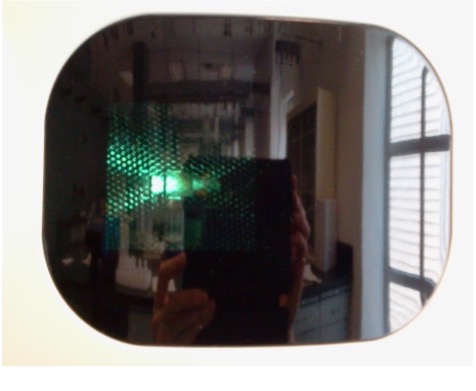
Inductively Coupled Plasma Optical Emission Spectrometer (ICPOES)
Applications: This instrument is used for quantitative chemical analysis of aqueous solutions. Samples are vaporized in an argon plasma and elements are quantified by light emission at characteristic wavelengths when the excited atoms transition to a lower energy state. Quantification is based on the principle that there is a proportional relationship between signal intensity and concentration. This technology can handle a wide variety of matrices (including organic, concentrated acids, HF, bases, and high dissolved solids, among others). The strength of this instrument is that the user can quantify a wide range of elements and concentrations simultaneously. Detection limits for most elements are in the parts-per-billion (ppb) range and upper limits may be as high as hundreds of parts-per-million (ppm). Any number of elements can be included in an analysis.
Instrumentation: Perkin Elmer Optima 8300 dual view spectrometer. Sample introduction systems are quickly interchangeable to accommodate different matrices. Data acquisition and data processing are performed using Perkin Elmer PC-based Syngistix software.
Sample Requirements: For optimal results, samples should be in stable aqueous solution with minimal matrix variability. For example – high pH and low pH samples should be analyzed separately. Samples that are high in dissolved solids, organic, or volatile (e.g. alcohols) may require dilution or other sample pre-treatment. Please contact the laboratory to discuss your particular application.
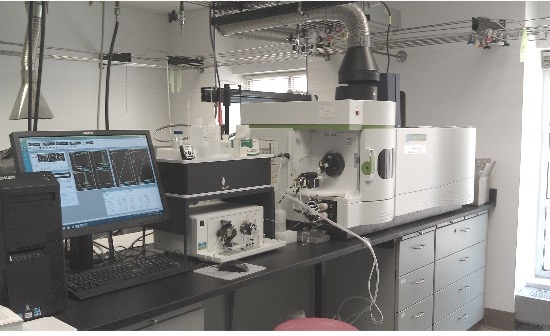
Inductively Coupled Plasma Mass Spectrometer (ICPMS)
Applications: The inductively coupled plasma mass spectrometer is also used for quantitative chemical analysis of aqueous solutions, however the technology, sample requirements, and detection limits of the instrument are different than that of ICPOES. Samples are vaporized in an argon plasma, however elements are differentiated based on their mass-to-charge ratio. Quantification is based on the principle that there is a proportional relationship between signal intensity and concentration. Detection limits for most elements are in the parts-per-trillion (ppt) range. Any number of elements can be included in an analysis.
Instrumentation: Thermo iCAPRQ single quadrupole mass spectrometer equipped with a He collision cell. Elements may be analyzed in standard or kinetic energy dispersion (KED) mode. In KED mode, helium is used as a collision gas to remove large molecules that create polyatomic interferences (e.g. ArCl mass = 75 and As mass = 75).
Sample Requirements: For optimal results, samples should be in stable aqueous solution with minimal matrix variability. Samples that are high in dissolved solids, organic, or volatile (e.g. alcohols) may require dilution or other sample pre-treatment. Please contact the laboratory to discuss your particular application.
Aqueous sampled should have less than 0.2% total dissolved solids and acid concentration should be <2%. However, because instrument detection limits are in the ppt range, most samples can be diluted without loss of data.
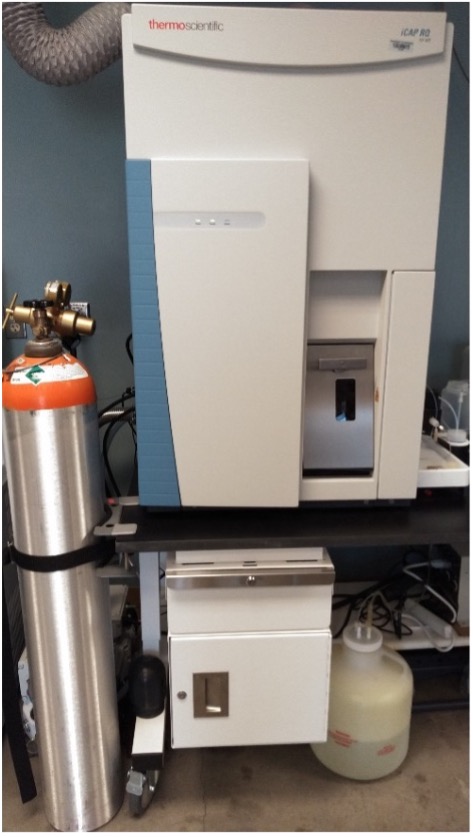
Ion chromatography
Applications: This instrument is for quantitative analysis of common anions and/or cations in aqueous samples. Aqueous samples are carried via a charged fluid (mobile phase) and introduced into a separation column which is packed with ion exchange resins (stationary phase). Constituent ions separate over time within the column based on their relative affinities for the mobile or stationary phase. Quantification is achieved by electrical conductivity. Quantification is based on the principle that there is a proportional relationship between conductivity and concentration. Detection limits for most anions are in the 0.1-0.4 parts per million range.
Instrumentation: Our Thermo ICS 6000 is equipped with a syringe auto sampler, a self-regenerating suppressor, and a conductivity detector. Sample volumes vary, but most quantifications use 10, 25, or 50 uL injection volume.
Sample Requirements: For accurate results, samples should be similar to that of water. We can analyze samples that range from fresh water to hypersaline. Samples that contain organics or high dissolved salts will be diluted.
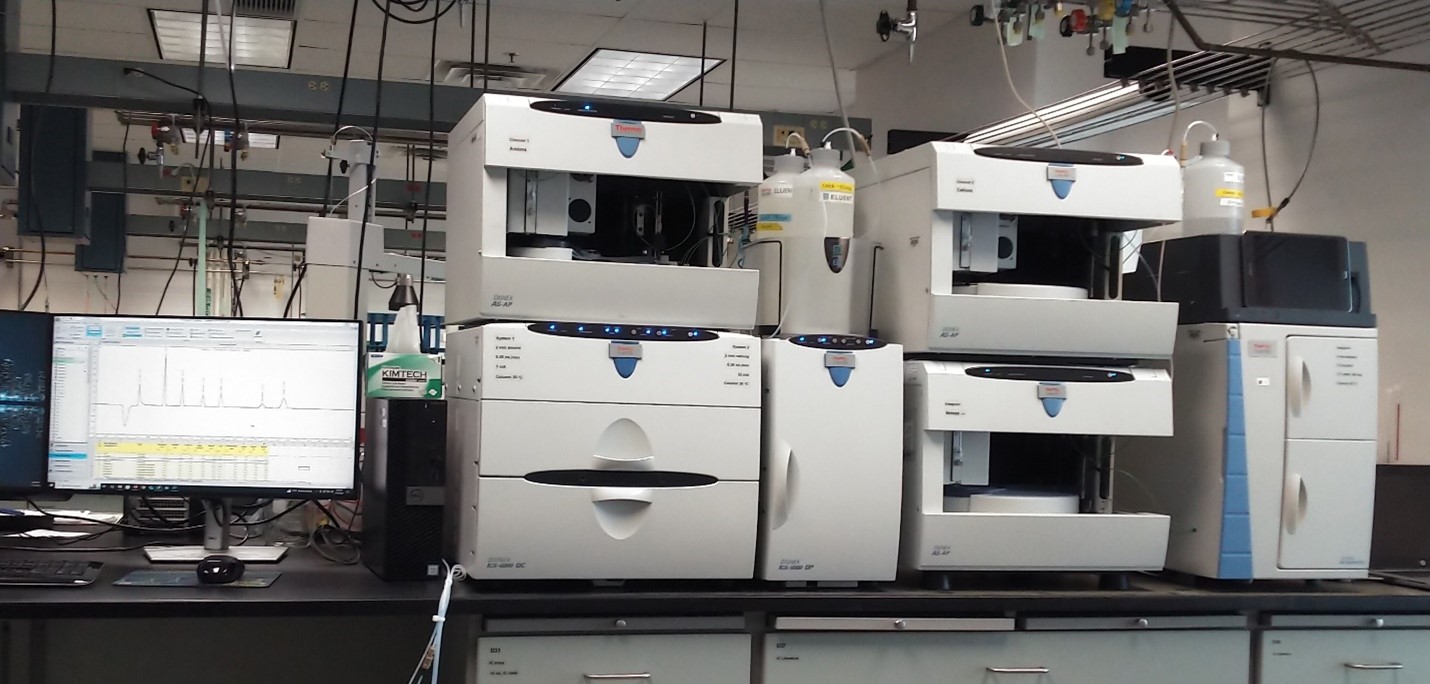
Surface Area and Pore Size Distribution
Applications: Nitrogen gas adsorption provides a measurement of specific surface area (SSA) and a semi-quantitative measurement of pore size distributions within the mesoporous range (between 2 to 50 nm) in porous samples. Samples (as either chips or powders) are placed in a sample tube, and the tube is evacuated. Vials are submerged in liquid nitrogen as gaseous nitrogen flows into the evacuated sample cells. The gaseous nitrogen cools and condenses onto sample surfaces and pores. Throughout the condensation process, pressure is measured relative to the pressure in a reference cell. The change in pressure over time provides an isotherm that is representative of the volume of gas adsorbed. Once the sample cell is saturated, the nitrogen is evacuated. The resulting adsorption and desorption isotherms are transformed to produce pore size distribution curves, and the linear portion of the adsorption isotherm is transformed to calculate specific surface area.
Instrumentation: We use a Micromeritics TriStar 3000 analyzer. The manifold is equipped with 3 sample ports. Standards are available for quality assurance of SSA measurements.
Sample Requirements: For specific surface area, the amount of sample is estimated as (10 / expected SSA). Samples can be chips or powders but must be able to fit through a tube with a ½ inch diameter opening. Pore size distribution requires sample density. Samples are prepared prior to analyzing by heating them and purging with helium (“degassing”). Duration and temperature for degassing are sample dependent.
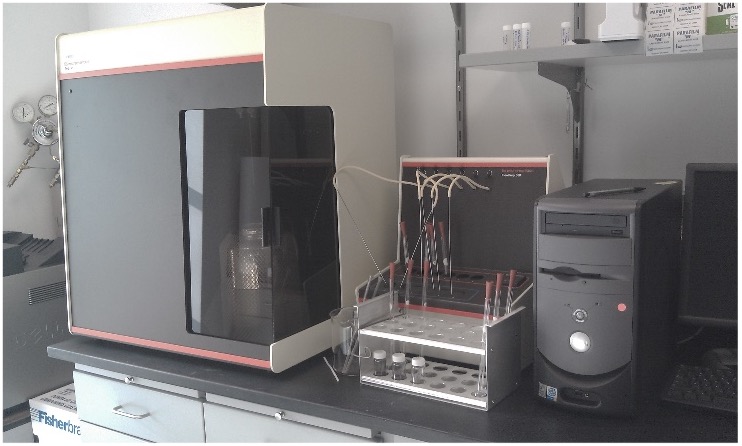
Macro Thermogravimetric analyzer (TGA)
Applications: Macro TGA enables quantification of weight-loss in solid materials at pre-programmed temperatures. Typical uses are to determine moisture, volatiles, and ash in coal (e.g. ASTM D-7852) and Loss on Ignition of soil and tissue samples.
Instrumentation: The LECO TGA 801 can hold up to 19 samples. Minimum sample size is typically 1 gram. Samples are pre-weighed using an internal balance and then weighed again at each pre-programmed temperature increment. LECO software permits user-defined programming. Data outputs are user-defined and include a graphical display.
Sample Requirements: Almost any solid material (rock, tissue, etc.) can be analyzed, however sample preparation will vary. Most samples should be air-dried and ground to pass a (U.S.) 60 mesh (250 micron) sieve. Wet samples may require more sample.
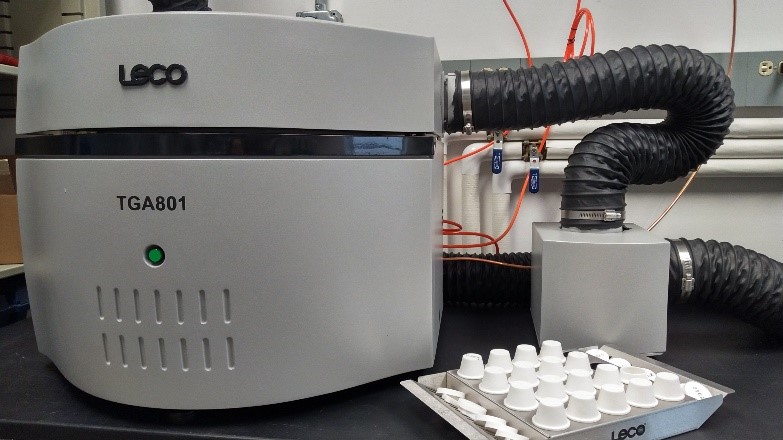
Coming Soon: Laser Ablation ICPMS!
The lab has acquired a Thermo iCAPTQ triple Quad mass spectrometer and an Iridia excimer laser. This technology will enable us to quantify elements and isotopes in solid samples such as thin section mounts. We anticipate the instrument to be available for use in early 2026.
Miscellaneous Equipment
The lab also houses centrifuges, ball mills, freeze dryer, walk-in refrigeration, muffle furnaces, drying ovens, analytical and microbalance, high throughput deionized water, and numerous other lab essentials.

